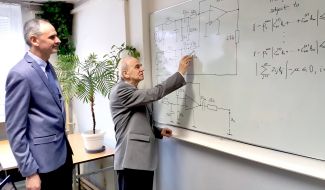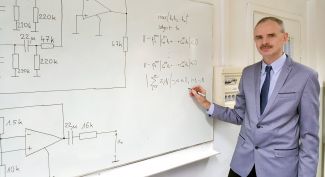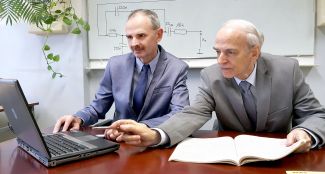Dynamic development of new technologies results in enhancement of functionalities that home electronic equipment and devices offer its users. The range and accessibility of products are changing, yet, what remains are problems with faults and their diagnosis. Professor Michał Tadeusiewicz and dr hab. inż. Stanisław Hałgas, prof. PŁ, of TUL’s Institute of Electrical Engineering Systems, have been working on detecting faults in electronic devices all of us use daily such as TV sets and phones.
What are analog electronic circuits?

The concept of analog or digital electronics is something very common in our everyday lives. Just think of device names in which these two adjectives are used such as clock, pressure gauge, thermometer, TV, radio.dr hab. Stanisław Hałgas, prof. PŁ i prof. Michał Tadeusiewicz Similar categorization applies to electronic circuits. The two major categories are analog and digital electronic circuits. Apart from those, there are also mixed-signal integrated circuits which have both an analog and a digital component on a single substrate.
Analog electronic circuits, in simple terms, enable processing of analog signals, that is quantities that are definite at every single point in time and have an infinite set of values. Digital electronic circuits, on the other hand, allow us to process digital signals where a digital signal is typically a specifically coded approximation of an analog signal at discrete points in time and values from a specific set. Signal processing is much easier in the digital domain due to the sheer computational capacity that this technique offers.
What is the range of their application?
In contemporary electronics, digital circuits rule the roost, and there have been dynamic advancements in this area since the 1970s. Digital sound recording or digital image recording is what we take advantage of when we play CDs, watch Blu-Ray movies or JPG images. Watching advanced digital technologies conquering the world of electronics, you could get the impression that analog circuits are becoming obsolete. This is not the case, though. The world around us is analog by nature. A continuous stream of information flows from an observed object to the observer. All modern devices that have sensors (e.g. a phone, a tablet, medical equipment) use analog circuits to amplify and to filter the signals it receives. Robust development of the Internet of Things, IoT, necessitates advances in electronic circuits for information systems, biomedicine, energy management, telecommunications etc. Recent innovations in analog circuits, their integration and miniaturization have been a major contribution to advancement in this domain. Therefore, even though nearly 90% of currently used circuits are digital, they would frequently prove useless, were they not working in tandem with specifically designed analog components.
What do we mean when we talk about analog circuit fault diagnosis?

Manufacturing contemporary electronic circuits is a very complex process that requires that extremely strict conditions be met. Even the slightest aberration from the prescribed manufacturing regime could cause parametric faults, and in some cases, even major catastrophic faults. Consequently, the circuit may not meet design specification, which shall result in its elimination. Components may also become damaged in the post-production stage as a result of material aging, overheating, tension, etc. Fault-diagnosis of analog circuits involves fault detection where the circuit performance is tested against the performance specification, fault location, and faulty parameter identification which means determination of their values. Fault detection is typically performed when the point is not to find faulty components but to eliminate malfunctioning circuits. In such cases, electronic circuits are treated as black boxes and their internal structure is irrelevant. Locating faults in integrated circuits is required to correct production processes. Identification of the faulty element provides designers with valuable information in the pre-production stage.
Why is analog electronic circuit fault diagnosis key for the design and operation of electronic circuits?
The cost of fault diagnosis accounts for 70% of the production cost of modern integrated circuits. It is estimated that around 90% of the total cost of testing mixed-signal circuits, where analog and digital circuits are integrated, is incurred by testing the analog circuit. Procedures that have been known for over 30 years, and which have been continually improved, are used in digital circuit testing. But for analog circuits, where the problem is incomparably more difficult, there are no general diagnostic standards or testing techniques.
Technological progress in manufacturing electronic circuits has been enormous. But we need to bear in mind that each new technology entails new types of faults that have been non-existent or irrelevant for the previous generation. As a result, both design engineers and scientists are continually faced with new challenges and are under increased pressure to develop research tools for this field. The phenomenon bears some similarity to drug design in a situation where the virus that causes the disease is constantly mutating.
How advanced is our current theoretical and practical understanding of analog circuit diagnosis?

The quest for effective analog circuit fault diagnosis procedures has started on a greater scale in the 1980s. As a result, a great deal of research material is available in this field today, which is a great contribution to science, but, which, unfortunately, has not been translated into significant practical application accomplishments. It could happen that, unlike for digital circuits, it will not be possible to develop homogenous procedures based on a common idea and capable of diagnosing faults in analog circuits, but rather that heterogeneous procedures will be developed for testing specific categories of faults and specific types of circuits. There has been a growing interest in these issues. In the last two years (2015-16), 446 research works were recorded in the SCOPUS database that focused on analog circuit diagnosis including 180 research papers published in scientific journals.
What contributions have you made to finding a solution to the problem?
Analog electronic circuit fault diagnosis has been the primary topic of our research since 2010, however, we did some work in this area before. Currently, this topic is pursued by a research team that is comprised of prof. dr hab. Michał Tadeusiewicz, dr hab. Stanisław Hałgas, prof. PŁ, dr inż. Andrzej Kuczyński, dr inż. Marek Ossowski, dr inż. Marek Korzyński, senior technician Andrzej Wrona. We have developed many original methods for many different aspects of analog electronic circuit fault diagnosis, with particular attention given to integrated circuits where micro- and nanometer technologies were used in the design. In our work, we took into account parametric variations of components that were not defective, limited access to measurement points, uncertainty of measurement readings and other factors that could have an impact on the reliability of the developed methods. We used a vast array of research tools: numerical analysis, linear programming, optimization, Circuit Theory and signal processing concepts. We also reached for artificial intelligence tools. The results of our research have been published in highly-respected global-reach JCR journals: IEEE Transactions on Circuits and Systems, IEEE Transactions on Instrumentation and Measurement, International Journal of Circuit Theory and Applications, Circuit Systems and Signal Processing, Journal of Electronic Testing, Analog Integrated Circuits and Signal Processing, Metrology and Measurement Systems. Recently, two The best paper awards have been awarded to M. Tadeusiewicz, A. Kuczyński, S Hałgas, the authors of a research paper published in the Circuits Systems and Signal Processing (Birkhäuser, Springer, New York).
What is the likelihood of developing effective analog circuit fault diagnosis procedures?

Before I can answer this question, I need to mention a few issues that make the task radically more complicated. Modern integrated circuits are composed of MOS transistors
which are semiconductors that can be characterized with models that include many interacting parameters and are described with several hundred equations. Consequently, even a simple circuit composed of only a few transistors has a very complex mathematical description. Different types of faults may occur in the circuit, and, what is more, process variations in non-defective parameters may conceal actual faults. To all that, you want to add limited measurement accessibility in integrated circuits and uncertainty of measured quantity readings. Under such conditions, comprehensive solutions to the problem of fault diagnosis, which includes detection, location and identification of faults, are highly unlikely. It seems more realistic to expect partial solutions, which would involve developing certain standards for specific categories of faults and types of circuits.
It is worth being a scientists because ...
Working out new ideas and original solutions to problems that are studied in research centers around the world is very fulfilling and makes you feel that you are making a contribution to the development of our civilization. This is true both for implementation projects as well as for theoretical accomplishments that lay the foundations for future implementations. Because, to quote Ludwig Boltzman, 'Nothing is more practical than a good theory'. It is worth being a scientist as long as you have strong drive and a flair for scientific work. It requires a passion, dedication and focus.
